中国科技论文在线
http://www.paper.edu.cn
基于 TDLAS 测量低压预混火焰三维温度分
布 #
蒋永,吴威,杨荟楠**
(上海理工大学能源与动力工程学院,上海,200093,中国)
摘要:由于可调谐半导体激光吸收光谱技术中传统的双线测温法只适用于温度均匀分布的测
量场合,并不适用于温度不均匀分布的场合。本文采用温度分级技术,通过同时扫描多条水
蒸气特征吸收谱线,研究纳米粒子制造反应器内低压预混平面火焰的三维温度分布状况。该
技术将光路划分为若干个温度区间,通过假定在每一段区间内温度是恒定的,且测量区域内
压强和水蒸气浓度也是均匀分布的,即可确定每个温度区间的长度。本文首先固定燃烧器头
部的位置,在与燃烧器头部平行的平面上按一定的步长改变激光束的位置获得火焰温度的二
维分布;再沿火焰传播的方向移动燃烧器头部,从而获得反应器内温度的三维分布信息。
关键词:光谱学;火焰温度;可调谐半导体激光吸收光谱;温度分级技术;三维分布
中图分类号:TK311
Three-dimensional Temperature Distribution of
Low-pressure Premixed Flame Measured by TDLAS
JIANG Yong, WU Wei, YANG Huinan
(School of Energy and Power Engineering,University of Shanghai for Science and
Technology,Shanghai,200093,China)
Abstract: The traditional two-line thermometry in tunable diode laser absorption spectroscopy
(TDLAS) is only suitable for the measurements in temperature homogenous distribution environments,
but not for inhomogeneous one. In this work, temperature-binning technique was employed to obtain
three-dimensional temperature distribution for low-pressure premixed flame in a nano-particle
synthesis reactor by scanning several water-vapor absorption lines. The beam path was divided into
several temperature sections, the temperatures were assumed to be constant in variable lengths along
the line of sight, when the pressure and water vapor mole fraction were also constant through the
measurement process, the length corresponded to each temperature can be determined. Here, at a fixed
height above burner position, by moving the laser beam in a plane parallel with the burner head with a
specific resolution, two-dimensional temperature information can be determined; by moving the burner
head in the direction of flame propagation, three-dimensional temperature information was obtained.
Key words: spectroscopy;flame temperature; TDLAS; temperature-binning technique,;3D distribution
5
10
15
20
25
30
35
1 引言
近年来,具有半导体特性的金属氧化物纳米粒子被广泛地应用于气体传感器、光催化剂
和光电子器件等方面[1]。火焰燃烧法是目前制备这类粒子最可靠的方法之一,该方法通过纳
米粒子制造反应器内低压预混火焰中金属有机先驱物的蒸发而制备纳米粒子。其中温度是影
40
响纳米粒子属性的主要因素。为了模拟纳米粒子的形成和生长,对反应器内的温度测量是至
关重要的,同时测量火焰温度的三维分布也将为深入研究火焰结构对纳米粒子生长过程的影
响奠定良好的基础。
基金项目:国家自然科学基金(51676130、51306123)、博士点基金联合资助课题新教师类(20133120120008)
作者简介:蒋永(1993-),男,硕士研究生,主要研究液膜多参数同步测量
通信联系人:杨荟楠(1983-),女,博士,副教授,硕导,主要从事激光光谱测量方面的研究. E-mail:
yanghuinan@usst.edu.cn
- 1 -
�
45
50
55
60
65
70
中国科技论文在线
http://www.paper.edu.cn
激光光谱法是对温度进行无干扰在线测量最有效的方法之一[2],其中如基于光纤的可调
谐半导体激光吸收光谱(Tunable diode laser absorption spectroscopy, TDLAS)气体温度检测技
术[2-3]。这种方法因具有体积小、成本低、可靠性高、不需添加试剂和易于操作等优点被广
泛的应用于气体温度测量。水蒸气作为有机物燃烧的主要产物,在近红外区域存在大量的吸
收谱线,因此本文选择水蒸气作为检测的目标成分。目前 TDLAS 技术中广泛运用的双线测
温方法[4-8]只能提供测量光路的平均温度,而在温度不均匀分布的测量场合该技术具有很大
的应用局限性。在纳米粒子反应器中,流体的不均匀混合,器壁与外界的热传导及浮力效应
等因素的影响导致了反应器内温度呈不均匀分布。因此,一种针对温度不均匀分布测量环境
的检测方法是必要的。
本文采用由 Sanders 等学者提出的温度分级技术[9],同时扫描多条水蒸气特征吸收谱线,
将光路划分为若干个温度区间,通过假定在每一段区间内温度呈均匀分布,且测量过程中水
蒸气组分浓度和压强也是均匀的,即可确定每个温度所对应长度占总光程的百分数。Hecht[10]
等曾利用多线一氧化氮激光诱导荧光方法(NO-LIF)[11-12]获得了纳米粒子反应器内温度的二
维分布。本文基于该研究假定纳米粒子反应器内温度分为四个区间(400,550,800,1000 K),采
用四个分布反馈式半导体激光器,覆盖到具有不同的温度灵敏度的五个水蒸气吸收谱线。假
定温度从反应器轴对称中心到器壁是呈对称分布的,首先在某个特定的燃烧器头部高度位置
且与燃烧器头部平行的平面上按一定的步长改变激光束的位置可重建反应器内二维温度的
分布;再沿火焰传播的方向移动燃烧器头部,可获得温度的三维分布信息。
2 多波长 TDLAS 测温原理
=
( )
对于在近红外区域一个独立水蒸气的吸收谱线 i,吸光度可以用下式表达:
LpxTSA
i
(1)
式(1) 中,p [bar]表示气体的压强,xabs 是水蒸气的组分浓度,L [cm]表示光程,Si(T)
[cm-2bar-1] 是温度 T [K]对应的吸收谱线 i 的线强度。如果被测对象的温度是呈均匀分布的,
双线测温法[3,13]是适用的,气体温度是通过分析两个吸收谱线强度的比值而确定的。在这种
情况下,两条谱线的吸光度具有相同的压强、水蒸气组分浓度和光程,因此两条谱线吸光度
abs
i
的比值可以简化成温度的函数。但是如果在光路中温度呈不均匀分布,且有明显的温度梯度,
双线测温法是不适用的。Sanders 等学者[9]提出的温度分级技术,将光路分为 n 段,每段长
度为 Li 对应一个恒定的温度 Ti,水蒸气组分浓度 xabs,i 及压强 pi。选取 m 个水蒸气的吸收谱
线,基于公式 1 可以推导出:
(
TSTS
(
2
TSTS
2
(
TSTS
2
)
(
Lpx
)
(
Lpx
)
(
Lpx
(
TS
(
n
TS
n
(
TS
nm
)
)
)
A
1
A
2
A
m
(
(
(
)
)
)
)
(2)
m
1
abs
n
=
abs
abs
1
2
1
1
1
2
m
1
2
)
)
1
2
⋅
如果光路中若干个温度区间(T1,T2,…,Tn)已给定,可确定只和温度相关的吸收谱线强度
矩阵 S。通过实验测定吸光度 Ai,且如果假定反应器内压强和水蒸气浓度是恒定的,可通过
非负值最小二乘法求解公式(2)中的未知参数 L。每个温度区间对应的长度占总光程的百分数
fj 可以通过下式求得:
- 2 -
�
中国科技论文在线
=
f
j
=
L
j
L
http://www.paper.edu.cn
(3)
abs
)
(
Lx
)
(
Lx
abs
j
n
=1
j
j
75
80
本文选取了具有不同温度灵敏度(即不同的低能级能量 E”)的五个水蒸气吸收光谱线
(6807.83/7185.59/7390.13/7154.35/7153.75 cm-1)。表 1 列出了 HITRAN2008[14]中提取的这五
个水蒸气吸收谱线对应的光谱参数。图 1 是反应器在一定条件下(水蒸气成分浓度:0.3,压
强:20 kPa,光程:40cm,温度:1000 K)基于表 1 的光谱参数模拟获得的水蒸气吸收谱线。
如图所示,吸收线 2 和 3 的吸光度大于 10%,而吸收线 1 和 5 的吸光度却小于 5%,因为这
两条吸收线对高于 1000K 的温度更为敏感。
表 1 水蒸气光谱参数
Table 1 Water vapor spectroscopic data
Line number
Transitions[cm-1]
Lower state energy E” [cm-1]
S296K [cm-1bar-1]
1
2
3
4
5
6807.83
7185.59
7390.13
7154.35
7153.75
0.4
0.3
0.2
0.1
e
c
n
a
b
r
o
s
b
A
0.0
6807.0
7153.75
1045.1
446.5
1789
2552.9
1.02e-6
1.97e-2
8.53e-2
3.67e-4
8.05e-6
1
6807.5
6808.0
6808.5
6809.0
Wavenumber [cm-1]
85
(a)吸收光谱线 1(6807.83cm-1)
(a)Simulated absorption lines 1 at 6807.83 cm-1
0.4
0.3
0.2
0.1
e
c
n
a
b
r
o
s
b
A
2
0.0
7184.0
7184.5
7185.0
7185.5
7186.0
Wavenumber [cm-1]
(b)吸收光谱线 2(7185.59 cm-1)
(b)Simulated absorption lines 2 at 7185.59 cm-1
- 3 -
�
中国科技论文在线
http://www.paper.edu.cn
0.4
0.3
0.2
0.1
e
c
n
a
b
r
o
s
b
A
3
90
0.0
7389.0
7389.5
7390.0
7390.5
7391.0
Wavenumber [cm -1]
(c)吸收光谱线 3(7390.13 cm-1)
(c)Simulated absorption lines 3 at 7390.13 cm-1
0.4
0.3
0.2
0.1
0.0
e
c
n
a
b
r
o
s
b
A
4
5
7153.0
7153.5
7154.0
7154.5
7155.0
7155.5
7156.0
Wavenumber [cm-1]
(d)吸收光谱线 4 和 5(7154.35 cm-1 和 7153.75 cm-1)
(d)Simulated absorption lines 4 and 5 at 7154.35 cm-1 and 7153.75 cm-1
95
图 1 基于表 1 列出的光谱参数在一定条件下(水蒸气成分浓度 0.3,压强:20kPa,光程:40cm,温度 1000K)
模拟所得的五条吸收光谱线
Fig. 1 Simulation of H2O absorption lines for the five wavenumber positions (a) 6807.83 cm-1 (b) 7185.59 cm-1
(c) 7390.13 cm-1 (d) 7154.35 cm-1 and 7153.75 cm-1 with spectroscopic parameters from Table 1. Conditions are:
Water vapor mole fraction: 0.3, reactor pressure: 20 kPa, optical path length: 40 cm,temperature:1000 K.
100
3 实验测量
在文献[11]中已对纳米粒子制造反应器进行了详细的描述。图 2 分别是该反应器的俯视
图(a)和侧视图(b)。如图 2a 所示,反应器由不锈钢制成,外径为 100 毫米,长为 300
毫米。一个平焰燃烧器被水平的放置在该反应器内,燃烧器头部是一个多孔的铜质圆盘,直
径为 45 毫米,内部装有水冷螺线管,用于稳定火焰。在 20 mbar 的环境中,形成 H2/O2/Ar(流
量分别为 600/800/300 毫升/分钟)的低压预混平面火焰。如图 2b 所示,观察窗口由两块楔形
石英玻璃(15º,直径 90 毫米)构成,两块石英玻璃间的距离为 150 毫米,激光束可在与燃烧
器头部平行的平面上按照一定的步长进行移动。
105
- 4 -
�
中国科技论文在线
http://www.paper.edu.cn
Detector
(a)
Pump
Collimator
Isolator
Fiber
combiner
H2/O2/Ar
6807.83 cm-1
7185.59 cm-1
7390.13 cm-1
7154.35&
7153.75cm-1
(a)反应器俯视图与 TDLAS 装置简图
(a)Top view through the reactor and TDLAS setup
(b)反应器侧视图
(b)Front view into the flat-flame reactor
图 2 (a)反应器俯视图与 TDLAS 装置简图(b)反应器侧视图
Fig.2 (a)Top view through the reactor and TDLAS setup(b)Front view into the flat-flame reactor
如图 2a 所示,采用 4x1 的 PLC 平面光波导分路器把带尾纤的四个分布反馈式半导体激
光器(NEL)连接到一个单模态的光纤(纤芯 9 微米);通过激光控制器(ILX LDC3908)调谐半导
体激光器的温度和电流;利用信号发生器产生 100 赫兹频率的锯齿波信号同时调谐选取的五
条水蒸气吸收谱线;利用法布里隔离器(Laser 2000)控制光单向传输;激光穿过火焰后利用
铟砷镓放大探测器(PDA10CS)采集信号。本文假定反应器内火焰是稳定的,因此可采用波长
时分法对信号进行分离。每个吸收光谱线线对应的吸光度可通过 LABVIEW 程序对采集的
信号自动处理并进行 Voigt 拟合求解获得。
4 实验结果与分析
温度分级技术中温度区间的选定是至关重要的[9]。Hecht[15]等人曾利用多线 NO-LIF 测温
法确定纳米制造反应器内低压预混火焰的温度发布,在不同的火焰器头部高度位置获得一系
列的温度场图像,但由于该方法受到观测窗口尺寸的限制,只能获得观察窗口直径大小(90
毫米)的温度图像。图 3 所示为在火焰器头部高度 5 厘米,反应器轴对称线上 10 毫米处 2 毫
米宽的温度带的平均温度值。黑色的点表示的是 NO-LIF 测得的温度值,而红色的是对该温
度值进行拟合后获得的二次多项式曲线。如图 3 所示,最高温度约为 1 000 K;由于 TDLAS
技术测量中光路约为 150 毫米,通过拟合可知对应的温度最低值约为 400 K。本文基于这个
结果确定了测量气体的温度的上下限,基于温度分级技术,将光路分为四个温度区间
(400,550,800,1 000 K)。
- 5 -
110
115
120
125
130
�
中国科技论文在线
http://www.paper.edu.cn
1100
1000
K
/
e
r
u
t
a
r
e
p
m
e
T
900
800
700
600
500
400
Data from NO-LIF
Polynomial fit
90 mm
-75
-60
-45
-15
-30
30
Distance from middle /mm
15
0
(b)
60
75
45
图 3 基于 NO-LIF 二维温度结果获取的反应器轴对称线上 10 毫米处的温度值及其拟合曲线
Fig.3 Temperature profile along the beam path of TDLAS 10 mm above the centerline evaluated from NO-LIF
本文选定三个火焰器头部不同的高度位置(3/5/7 厘米),在每个特定的高度位置,激光束
在与燃烧器头部平行的平面上按 2 毫米的步长移动,在每个平面上进行 36 次测量。假设反
应器内的水蒸气是均匀分布的。根据已选定的四个温度,可以确定五个水蒸气吸收光谱线对
应的吸收强度,由于水蒸气的吸光度可以由实验测定,基于方程(2)和(3),可以确定每个温
度对应的长度占总光程的比例。假定火焰是对称分布的,根据已获得的温度对应的长度分数,
可对反应器内的温度场进行重建。如图 4 所示,横坐标 0 值表示的是激光束穿过反应器轴中
心对称线,正值和负值分别对应反应器的上部与下部。实验表明,对于这三个不同的高度位
置,都具有同样的温度分布趋势;温度最高值出现在火焰器头部 3 厘米的高度位置;温度最
大值不在轴中心对称线位置而偏上部;且反应器轴中心对称线上方的温度高于下方;中间温
度 550 和 800 K 占据了最大的长度比例;而 1 000 K 主要位于中心区域;和预期的一样,400K
主要分布在火焰的外围。
(a)在火焰器头部位置为 3 厘米处温度对应的长度占总光程的百分数
(a)Length fractions of the temperature bins in planes parallel to the burner head at fixed Height above burner
135
140
145
150
m
m
/
e
n
i
l
r
e
t
n
e
c
m
o
r
f
e
c
n
a
t
s
D
i
40
30
20
10
0
-10
-20
-30
-40
0
10
20
400 K
550 & 800 K
1000 K
a) HAB 3 cm
80
90 100
40
50
30
70
Length fraction / %
60
40
30
20
10
0
-10
-20
-30
-40
m
m
/
e
n
i
l
r
e
t
n
e
c
m
o
r
f
e
c
n
a
t
s
D
i
(HAB) of 3 cm
400 K
550 & 800 K
1000 K
0
10
20
40
50
30
70
Length fraction / %
60
b) HAB 5 cm
80
90 100
(b)在火焰器头部位置为 5 厘米处温度对应的长度占总光程的百分数
(b)Length fractions of the temperature bins in planes parallel to the burner head at fixed Height above burner
(HAB) of 5 cm
- 6 -
�
中国科技论文在线
http://www.paper.edu.cn
m
m
/
e
n
t
i
l
r
e
n
e
c
m
o
r
f
e
c
n
a
t
s
D
i
40
30
20
10
0
-10
-20
-30
-40
0
10
20
400 K
550 & 800 K
1000 K
c) HAB 7 cm
80
90 100
50
40
30
70
Length fraction / %
60
(c)在火焰器头部位置为 7 厘米处温度对应的长度占总光程的百分数
(c)Length fractions of the temperature bins in planes parallel to the burner head at fixed Height above burner
(HAB) of 7 cm
图 4:在火焰器头部位置为 3(a)/5(b)/7(c)厘米处温度对应的长度占总光程的百分数
Fig.4 Length fractions of the temperature bins in planes parallel to the burner head at fixed Height above burner
(HAB) of 3(a), 5(b) and 7(c) cm, respectively
5 结论
文中介绍了基于多波长 TDLAS 技术测量低压预混平面火焰的三维温度分布。传统的两
线测温法只适用于温度均匀分布的测量场合,本文采用的温度分级法可以获得温度不均匀分
布环境中的温度分布信息。通过假定四个温度区间,在反应器内三个火焰器头部不同的高度
位置,确定每个温度所对应的长度占总光程的百分数。结果表明,温度最高值不在反应器的
轴对称中心位置,且火焰出现了上移,这是由浮力效应引起的。
[参考文献] (References)
for
and
laser
Diode
sensor
absorption
combustion
gas-dynamic
[1] V.Simanzhenkov,P.Ifeacho,H.Wiggers. et al. Synthesis of germanium oxide nanoparticles in low-pressure
premixed flames[J].J.Nanosci.Nanotechnol,2004,4(1-2):157-61
[2] M.G.Allen.
flows[J].Meas.Sci.Technol,1998,9(4):545-562.
[3] X.Zhou, X.Lin, J.B.Jeffries. et al. Development of a sensor for temperature and water concentration in
combustion gases using a single tunable diode laser[J].Meas.Sci.Technol,2003,14:1459-1468.
[4] J.T.C.Liu,G.B.Rieker,J.B.Jeffrie.s et al.Near-infrared diode laser absorption diagnostic for temperature and
water vapor in a scramjet combustor[J].Appl.Opt,2005,44(31):6701-6711.
[5] D. W. Mattison,J. T. C. Liu,J. B. Jeffries. et al. Tunable diode-laser temperature sensor for evaluation of a
valveless pulse detonation engine[C]. The 43rd AIAA aerospace sciences meeting and exhibit, 2005, 2005-0224.
[6] M. P. Arroyo, R. K. Hanson. Absortpion measurement of water-vapor concentration temperature, and
line-shape parameters using a tunable InGaAsP diode laser[J]. Appl.Opt., 1993, 32(30): 6104-6116.
[7] M. P. Arroyo,S. Langlois, R.K.Hanson. Diode-laser absorption technique for simultaneous measurements of
multiple gasdynamic parameters
in high-speed flows containing water vapor[J]. Appl.Opt., 1994, 33
(15):3296-3307.
[8] W. G. Bessler, C. Schulz, V. Sick. et al.A versatile modeling tool for nitric oxide LIF spectra[C]. Proc. of the
3rd Joint meeting of the US sections of the Combustion Institute, Chicago, 2003.paper PI05
[9] D. S. Baer, R. K. Hanson, M. E. Newfield. et al. Multiplexed diode-laser sensor system for simultaneous H2O,
O2, and temperature measurements[J]. Opt. Lett., 1994, 19(22):1900-1902.
[10] S. T. Sanders, J. Wang, J. B. Jeffries. et al. Oxygen measurements at high pressures with vertical cavity
surface-emitting lasers [J]. Appl. Phys. B., 2001, 40(7):4404-4415.
[11] H. Kronemayer, P. Ifeacho, C. Hecht. et al. Gas-temperature imaging in a low-pressure flame reactor for
nano-particle synthesis with multi-line NO-LIF thermometry[J]. Appl. Phys. B, 2007, 88(3):373-377.
[12] W. G. Bessler, C. Schulz. Quantitative multi-line NO-LIF temperature imaging[J]. Appl. Phys. B, 2004,
78:519-533.
[13] L. S. Rothman, D. Jacquemart, A. Barbe. et al. The HITRAN 2004 molecular spectroscopic database[J].
- 7 -
155
160
165
170
175
180
185
190
�
中国科技论文在线
Journal of Quantitative Spectroscopic & Radiative Transfer., 2005, 96(2):139-204.
[14] X. Zhou, X. Liu, J.B. Jeffries. et al. Development of a sensor for temperature and water concentration in
combustion gases using a single tunable diode laser[J]. Meas. Sci. Technol., 2005,16(2):2437-2445.
[15] C. Hecht, H. Kronemayer, T. Dreier. et al. Imaging measurements of atomic iron concentration with
laser-induced fluorescence in a nanoparticle synthesis flame reactor[J]. Appl. Phys. B., 2009, 94(1):119-125
http://www.paper.edu.cn
195
200
- 8 -
�
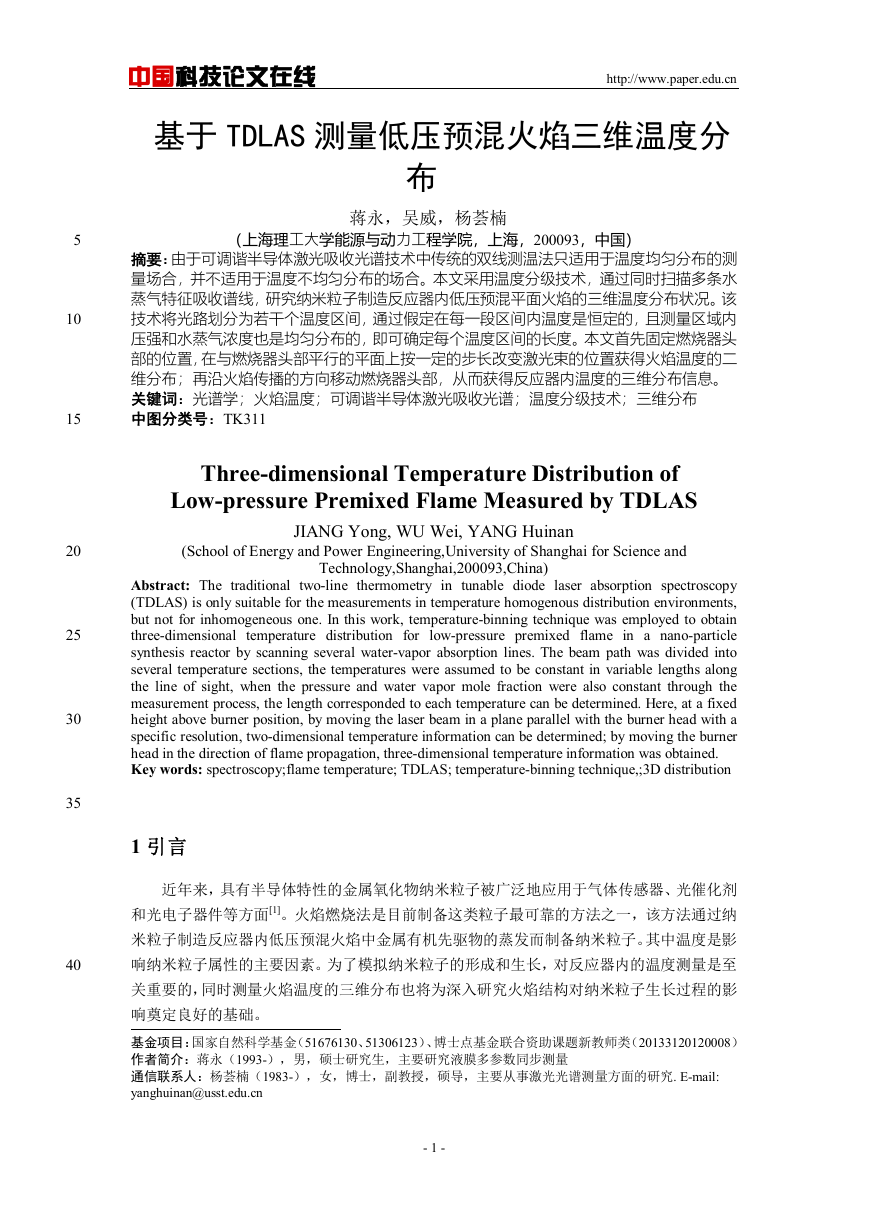
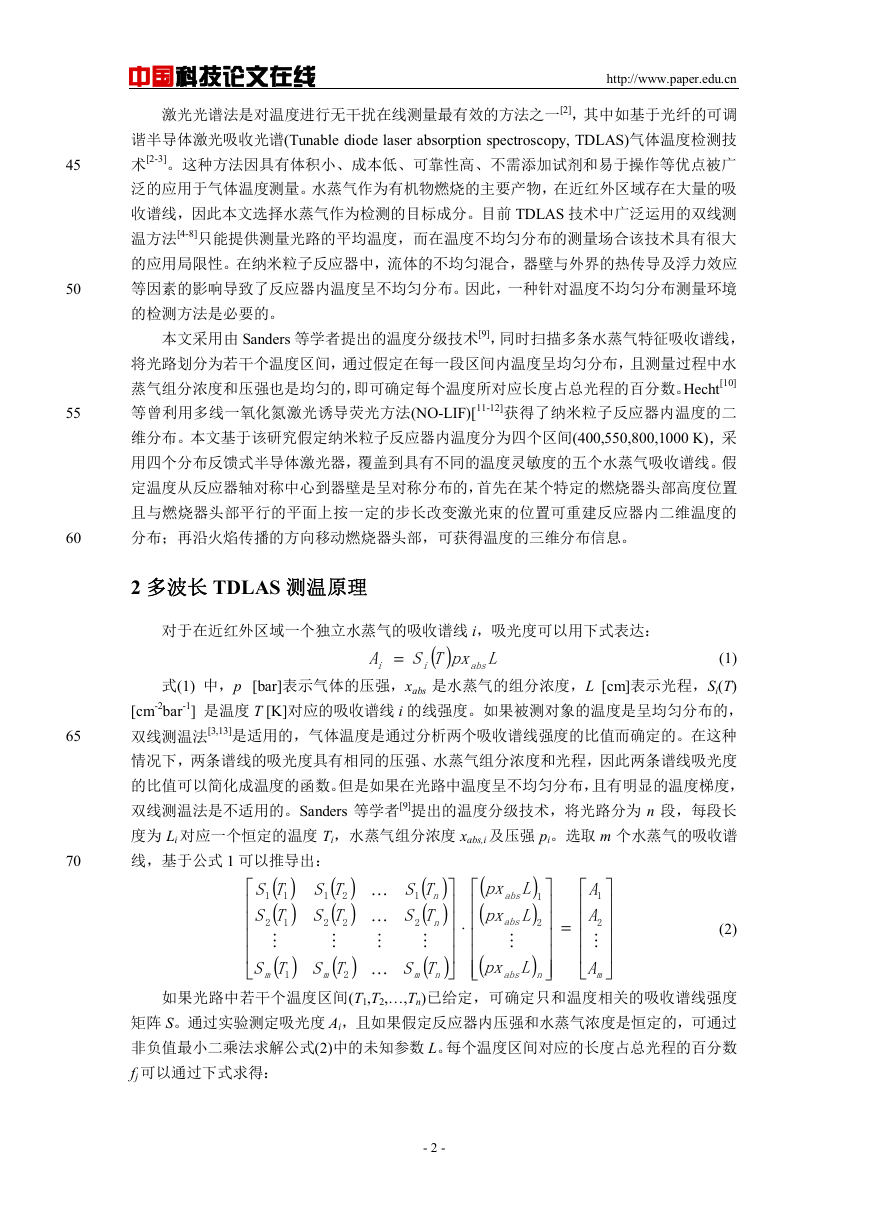
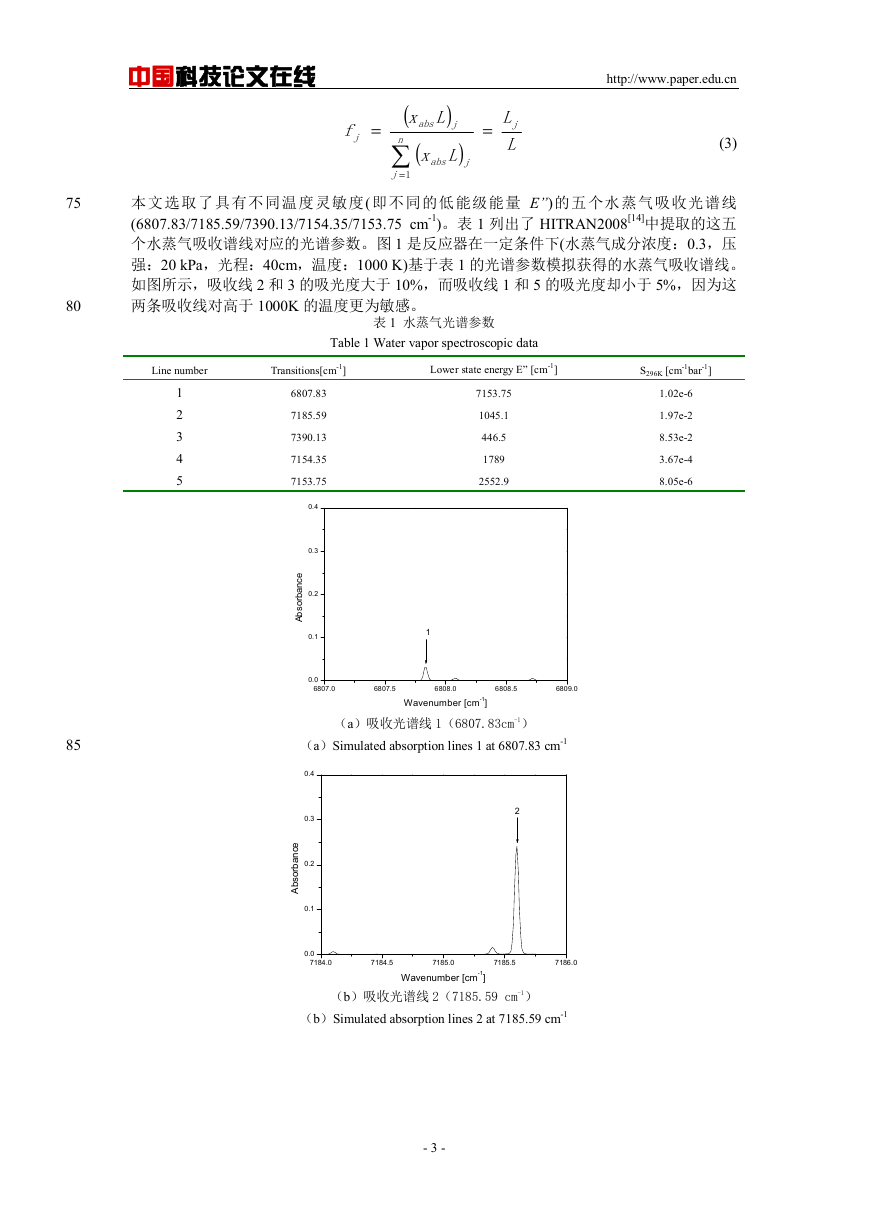

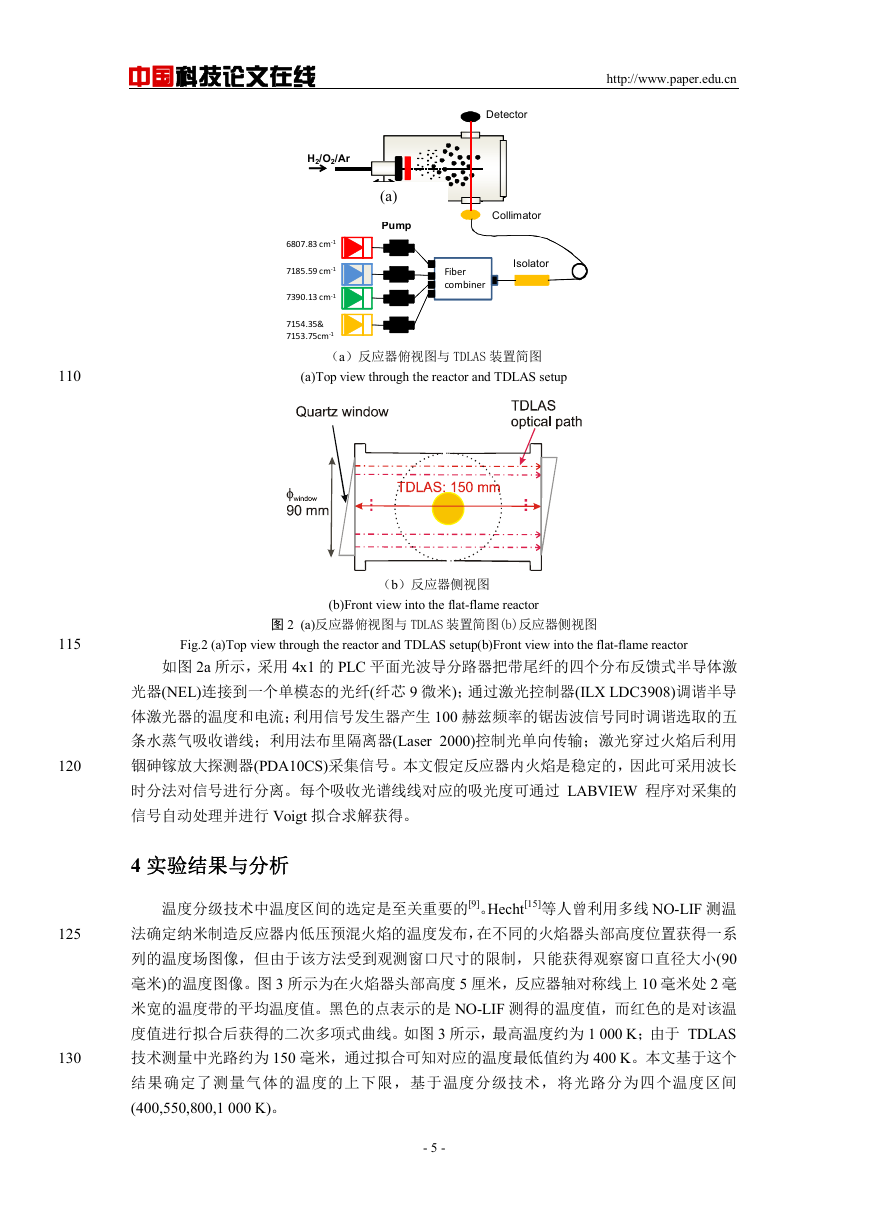
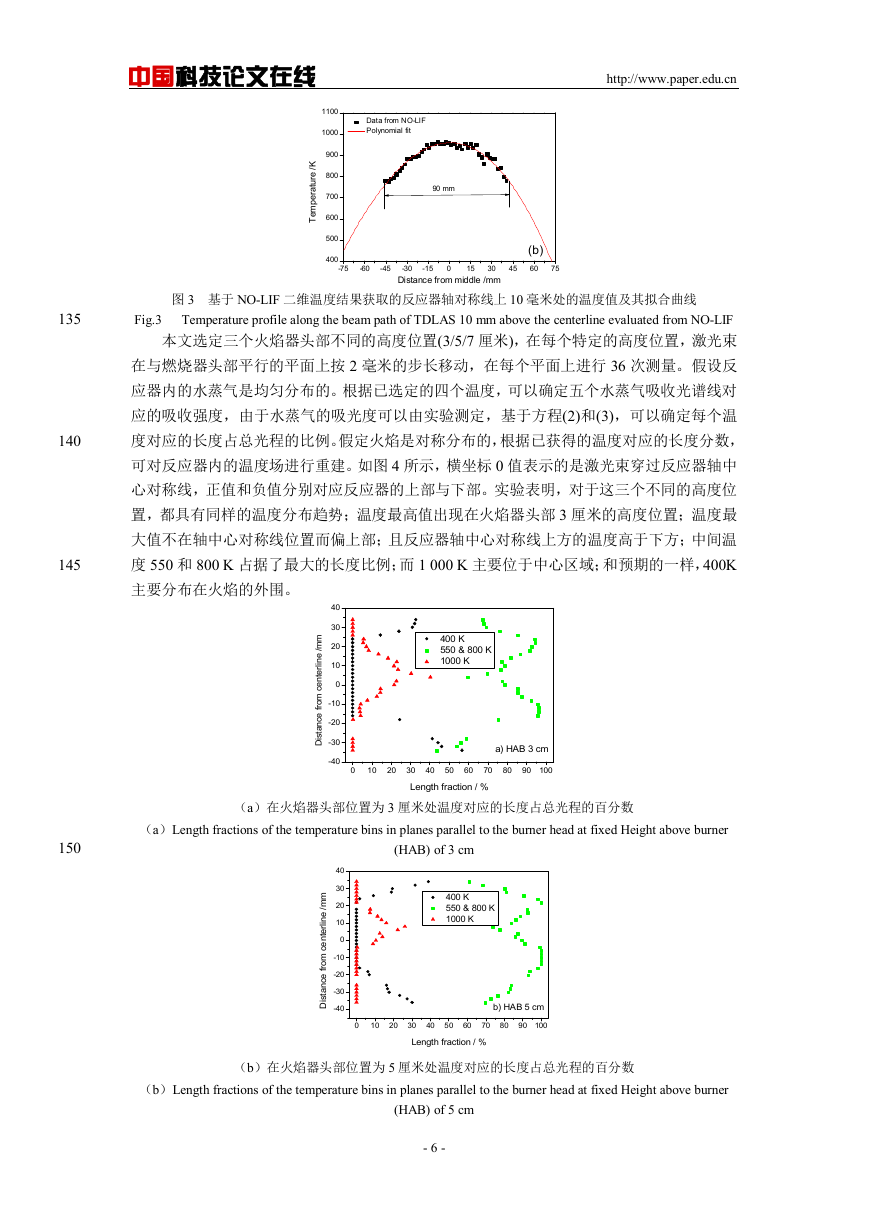
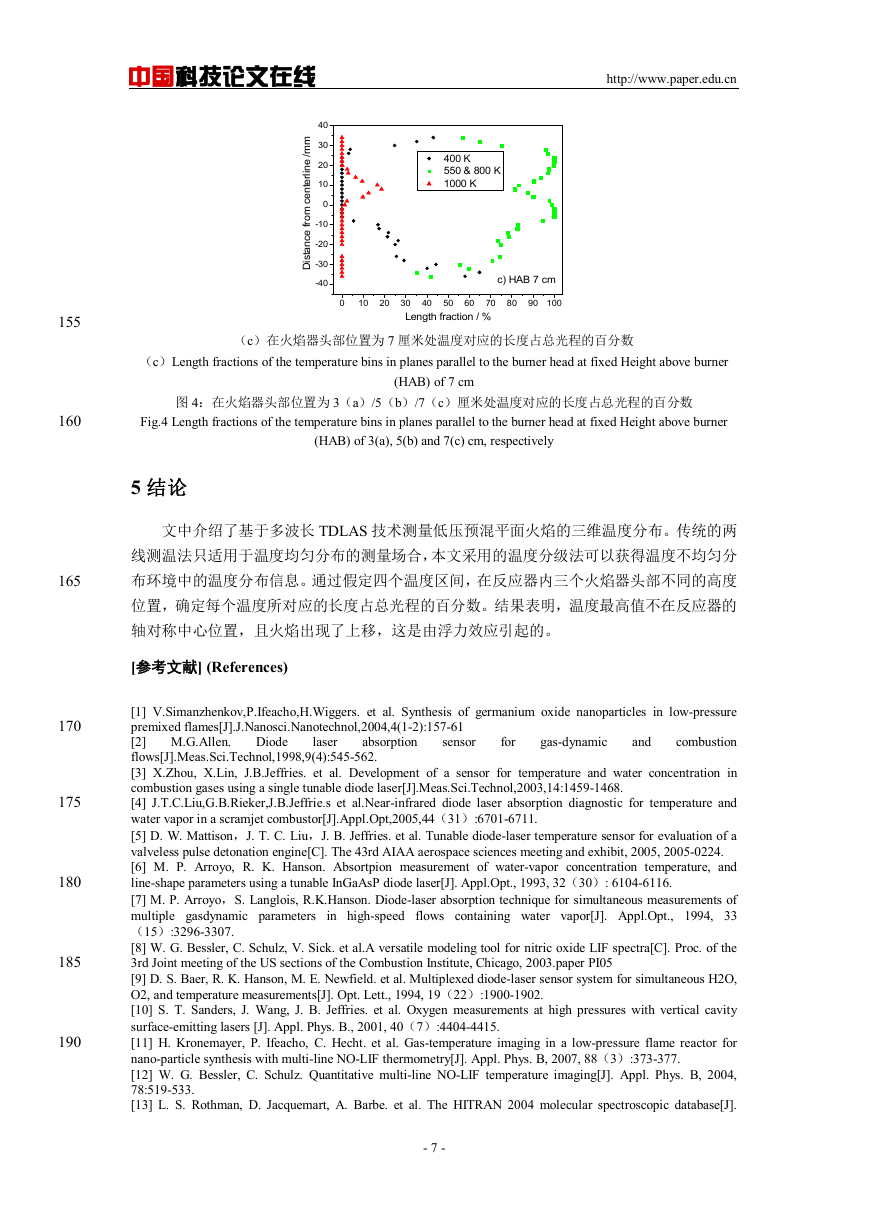









 2023年江西萍乡中考道德与法治真题及答案.doc
2023年江西萍乡中考道德与法治真题及答案.doc 2012年重庆南川中考生物真题及答案.doc
2012年重庆南川中考生物真题及答案.doc 2013年江西师范大学地理学综合及文艺理论基础考研真题.doc
2013年江西师范大学地理学综合及文艺理论基础考研真题.doc 2020年四川甘孜小升初语文真题及答案I卷.doc
2020年四川甘孜小升初语文真题及答案I卷.doc 2020年注册岩土工程师专业基础考试真题及答案.doc
2020年注册岩土工程师专业基础考试真题及答案.doc 2023-2024学年福建省厦门市九年级上学期数学月考试题及答案.doc
2023-2024学年福建省厦门市九年级上学期数学月考试题及答案.doc 2021-2022学年辽宁省沈阳市大东区九年级上学期语文期末试题及答案.doc
2021-2022学年辽宁省沈阳市大东区九年级上学期语文期末试题及答案.doc 2022-2023学年北京东城区初三第一学期物理期末试卷及答案.doc
2022-2023学年北京东城区初三第一学期物理期末试卷及答案.doc 2018上半年江西教师资格初中地理学科知识与教学能力真题及答案.doc
2018上半年江西教师资格初中地理学科知识与教学能力真题及答案.doc 2012年河北国家公务员申论考试真题及答案-省级.doc
2012年河北国家公务员申论考试真题及答案-省级.doc 2020-2021学年江苏省扬州市江都区邵樊片九年级上学期数学第一次质量检测试题及答案.doc
2020-2021学年江苏省扬州市江都区邵樊片九年级上学期数学第一次质量检测试题及答案.doc 2022下半年黑龙江教师资格证中学综合素质真题及答案.doc
2022下半年黑龙江教师资格证中学综合素质真题及答案.doc